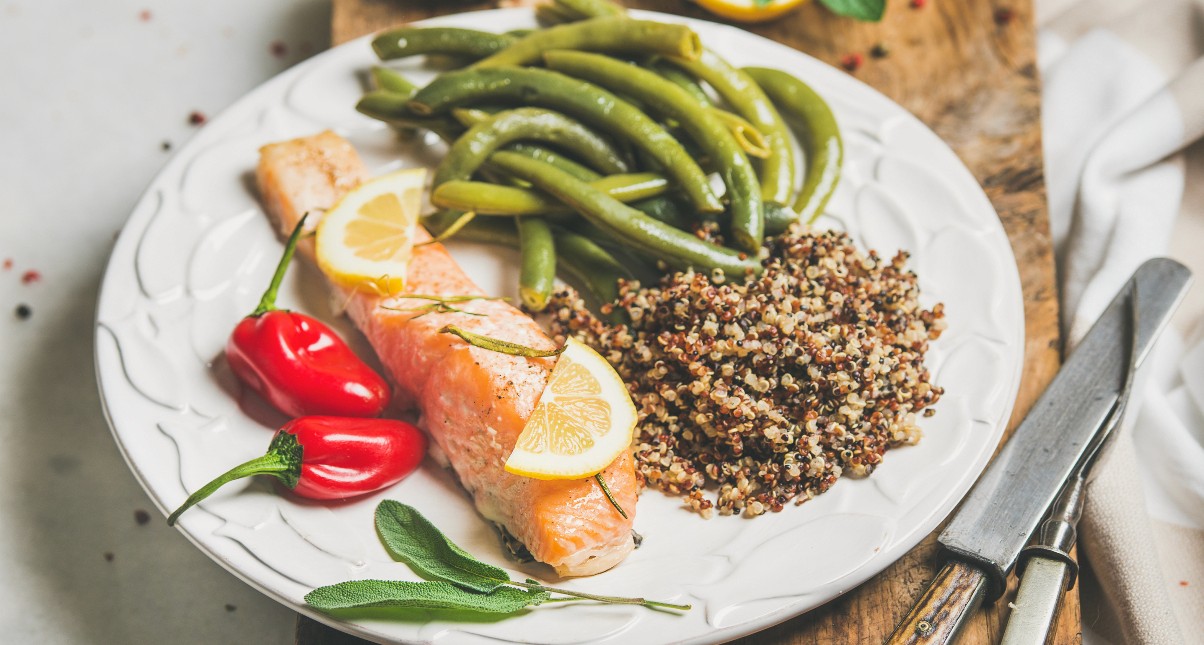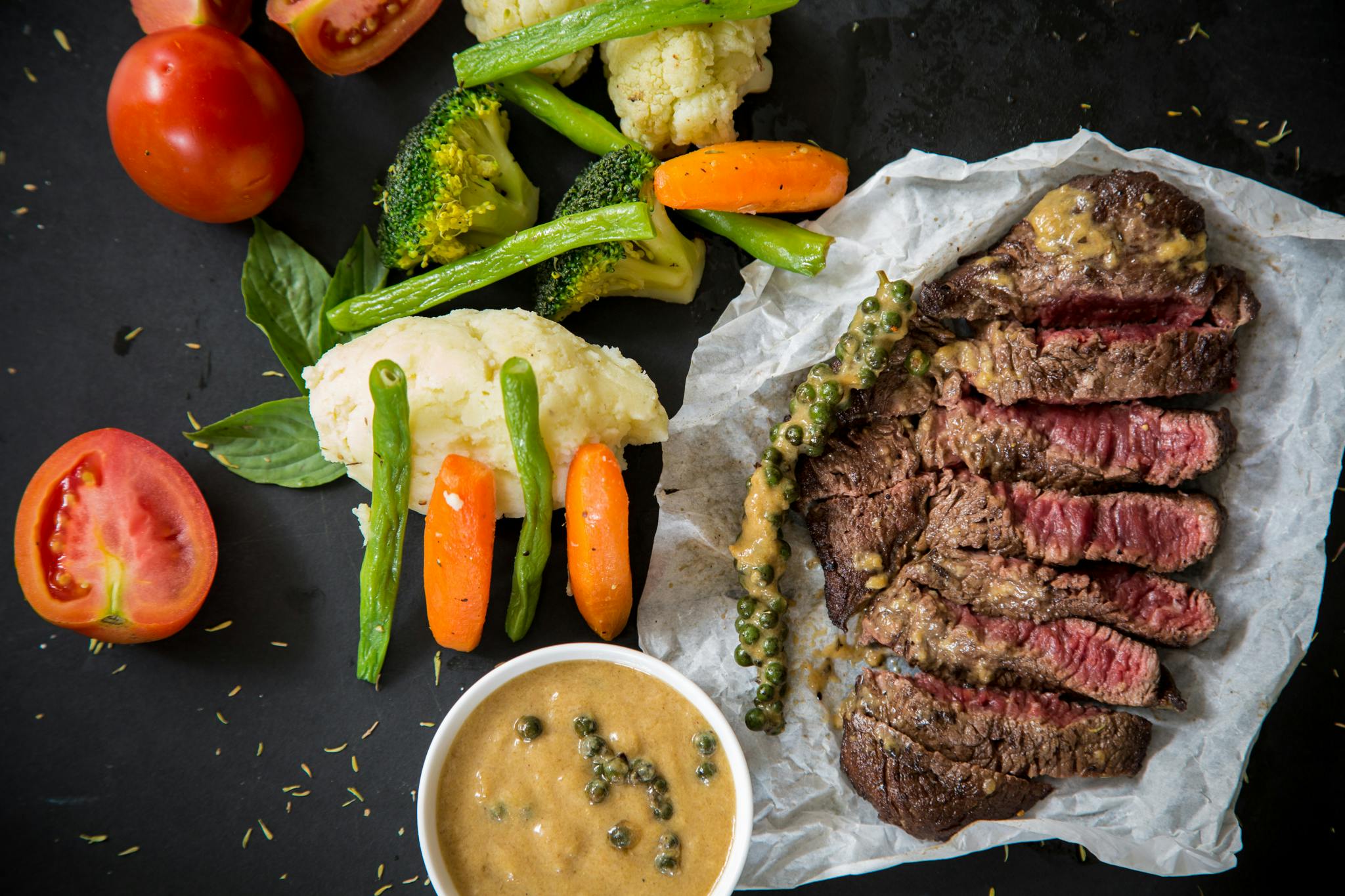Whether you’ve been diagnosed with diabetes recently or in the past, managing your blood sugar levels can sometimes feel overwhelming. Rest assured though, that when it comes to food, your meals don’t have to be strict or rigid.
Enter: the Diabetes Plate Method. Originally created by the American Diabetes Association (ADA), the Diabetes Plate Method is an easy way to approach mealtime that ensures you’re getting the proper portion sizes of each food group for a balanced meal. It’s also flexible enough that you can incorporate your favorite foods, without having to compromise your blood sugar control or health goals. Keep reading to learn more about how it works - no counting, calculating, or measuring needed.
First, imagine your plate. Start with a reasonably-sized plate, about 9 inches across. Next, visualize two lines on your plate - one line drawn down the middle, and another line dividing one side in half. Follow the steps below to fill it up!
1. Fill half your plate with non-starchy vegetables
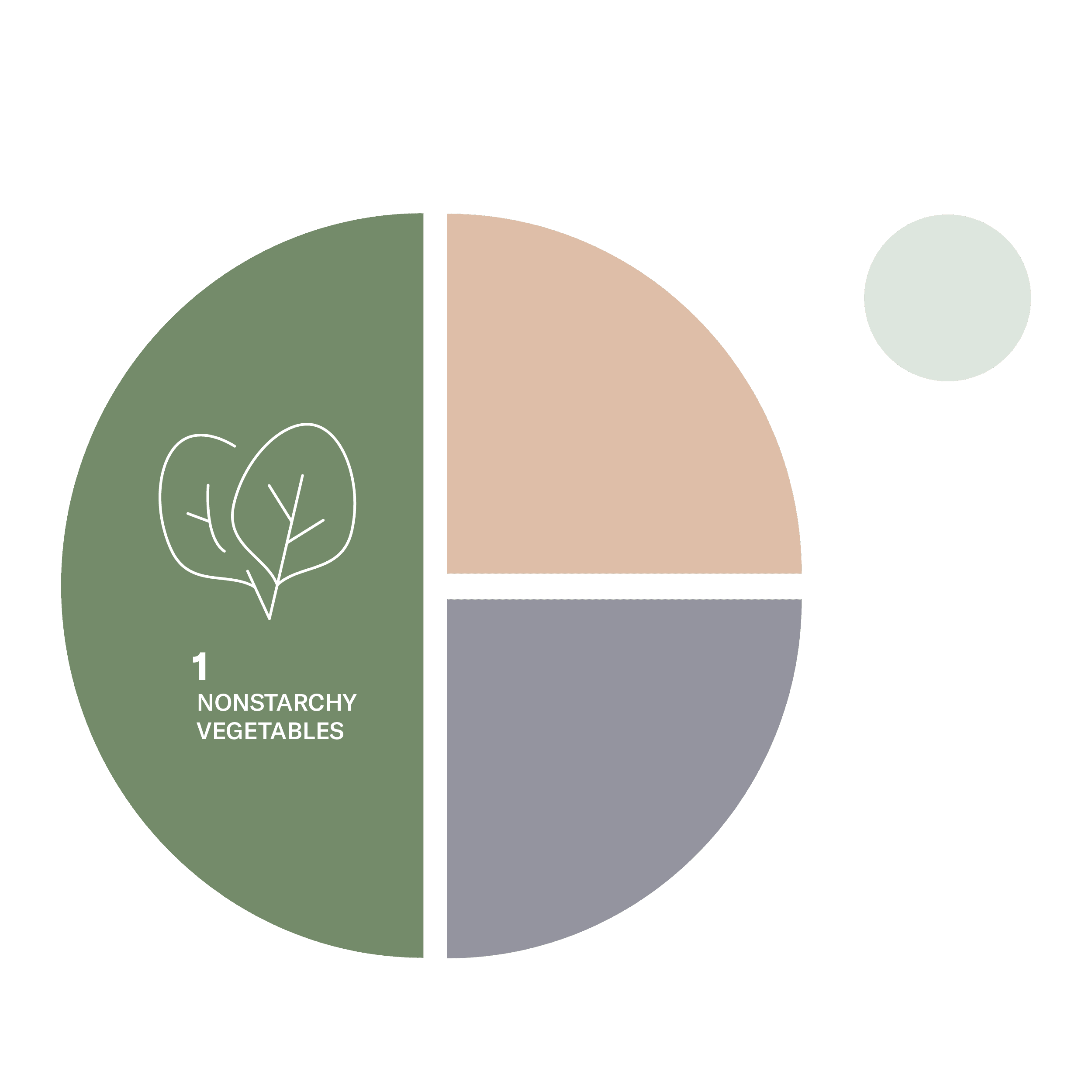
Non-starchy vegetables are lower in carbohydrates and high in fiber, so they don’t raise blood sugar as much as starchy vegetables. Examples of non-starchy vegetables include broccoli, lettuce, cauliflower, spinach, carrots, and bell peppers.
2. Fill one quarter of your plate with lean protein
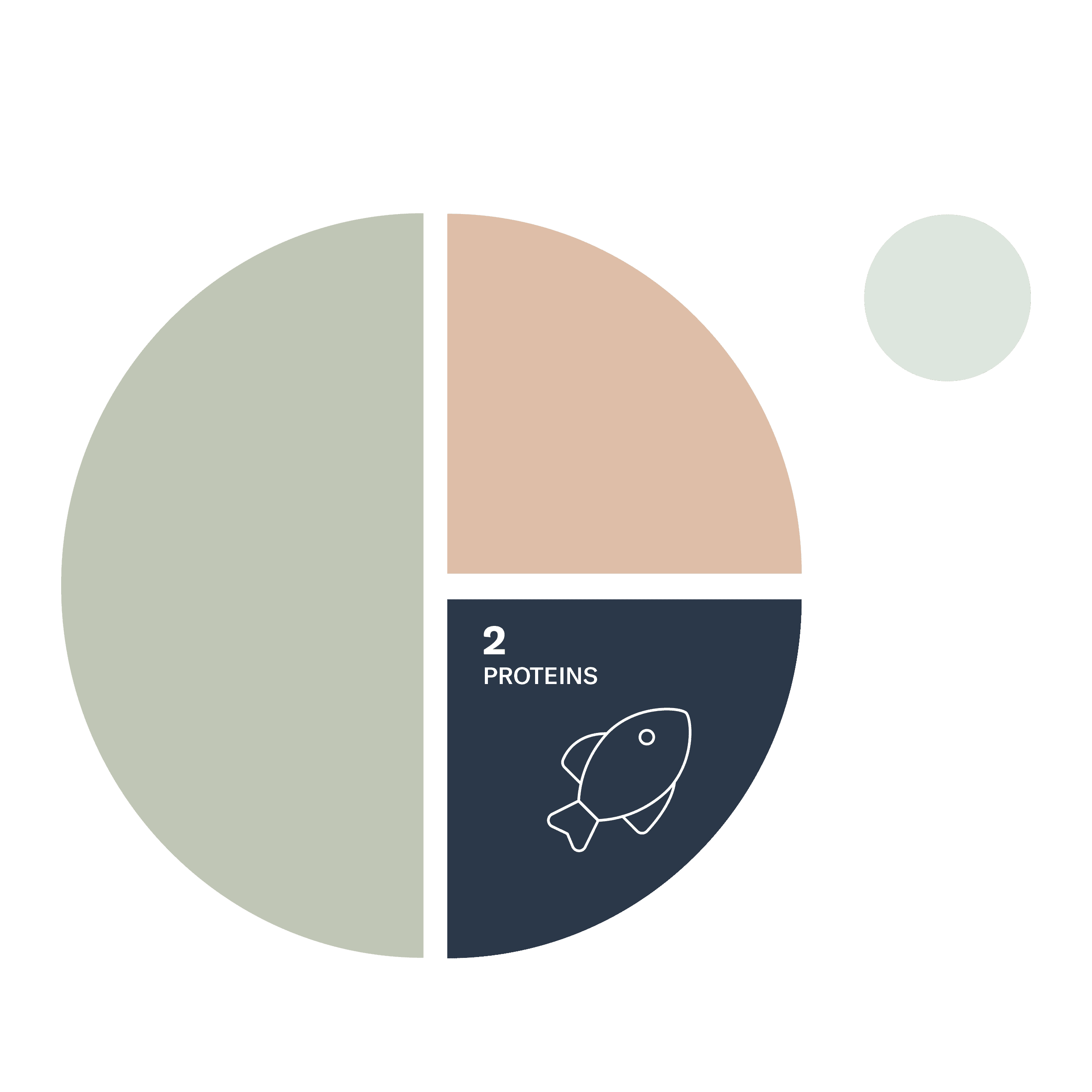
“Lean” protein refers to protein sources that are lower in total fat and saturated fat. Lean animal protein sources include chicken, turkey, eggs, salmon, tuna, shrimp, and lean beef cuts (chuck, round, sirloin, flank, or tenderloin). There are also plant-based sources of protein, including tofu, tempeh, nuts and nut butters, beans, lentils, and hummus. Remember that some plant-based protein foods, such as beans and legumes, are also high in carbohydrates.
3. Fill one quarter of your plate with carbohydrate foods
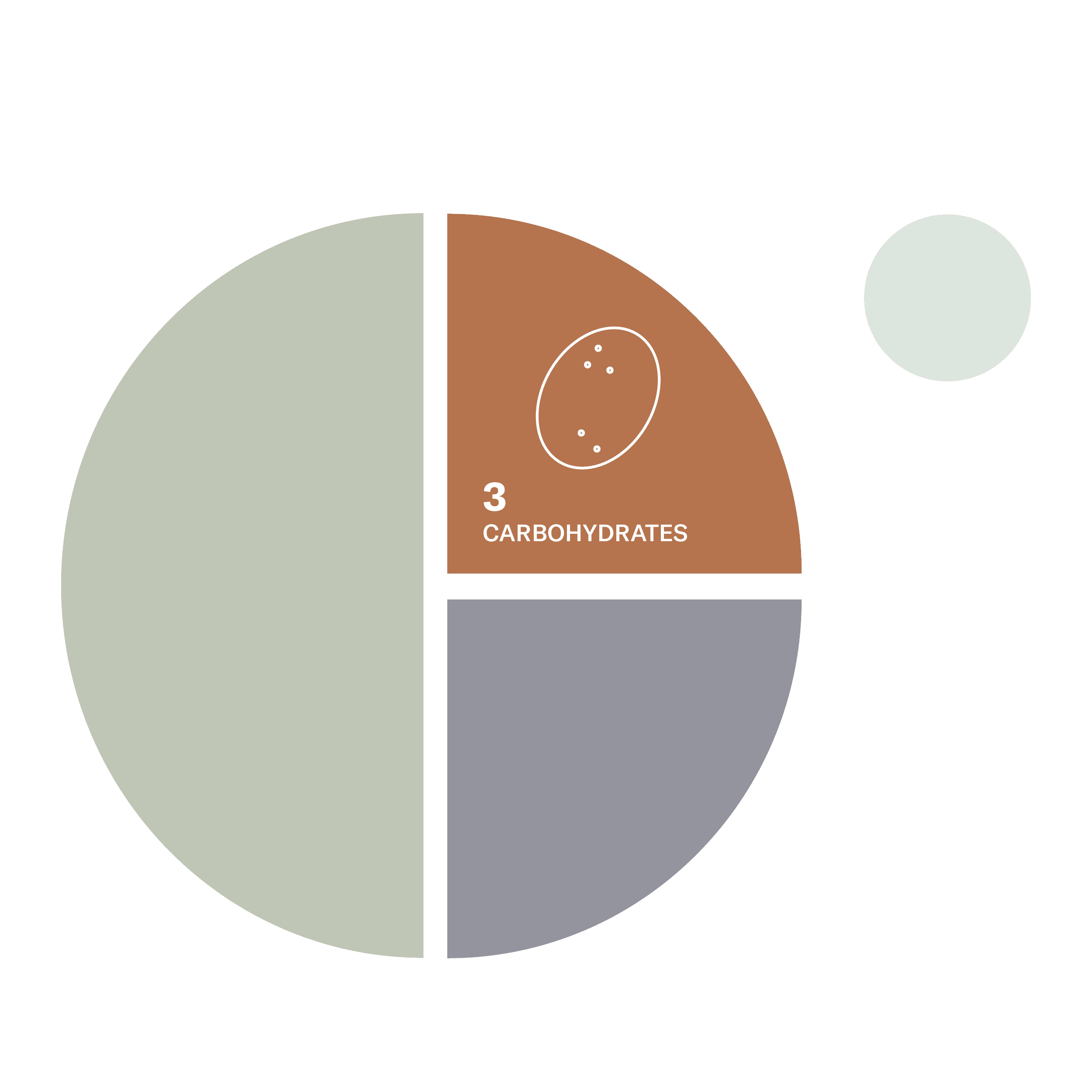
Examples of carbohydrate foods include starchy vegetables (corn, potatoes), grains, beans, chickpeas, and lentils. Limiting your portion of these foods to one quarter of your plate can help keep your blood sugar from rising too high.
4. Choose water or a low-calorie drink
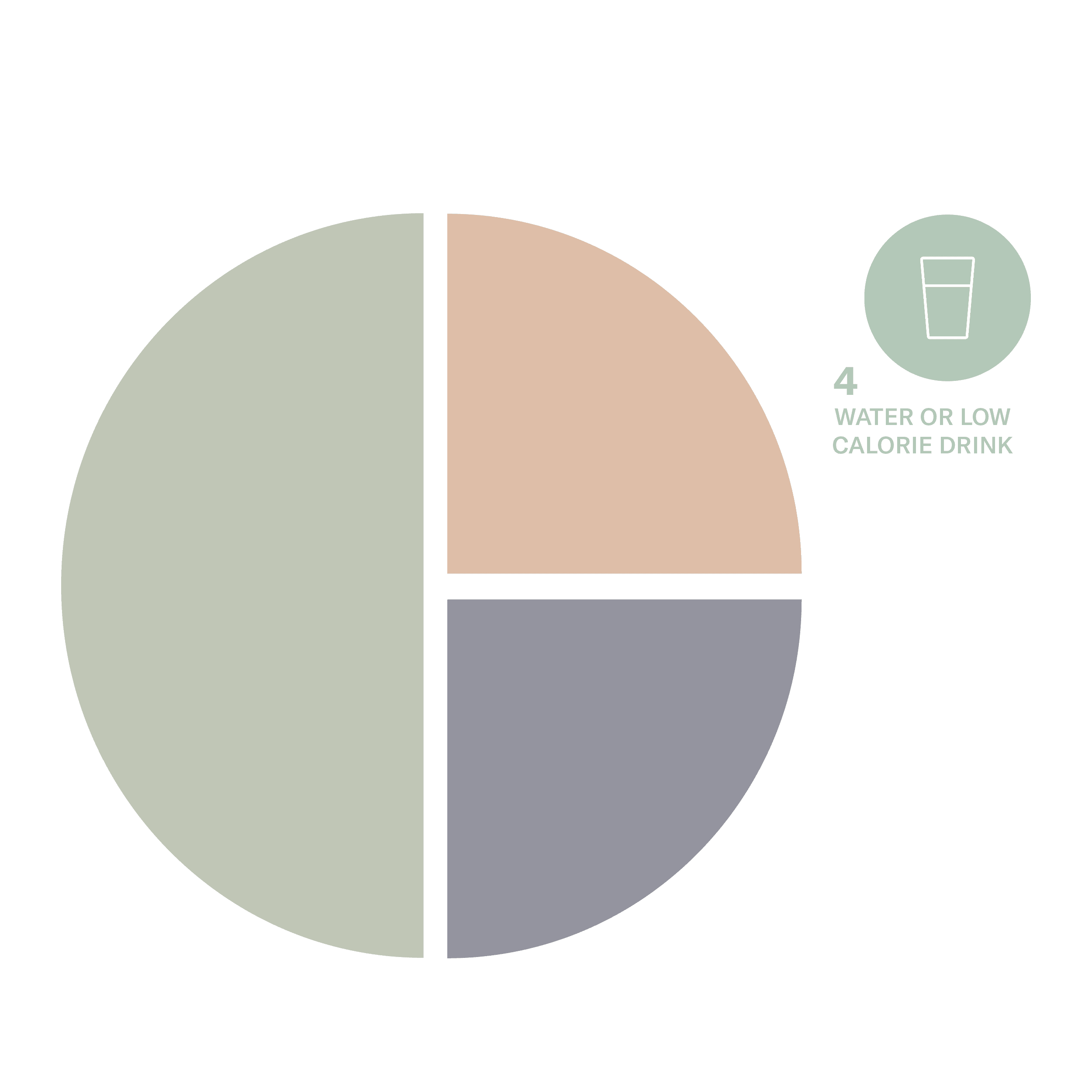
Water has no calories or carbohydrates, meaning it has no effect on your blood sugar. Other low-calorie drinks include unsweetened tea, sparkling water or seltzer, and flavored water without added sugar.
What about meals that don’t fit this plate method?
For meals that can’t be sectioned off into portions on a plate, like pasta, pizza, soups, or sandwiches, think about the combination of foods in each dish. For example, in a turkey sandwich, the bread would make up the carbohydrate portion, turkey the protein, and lettuce or tomatoes the non-starchy vegetables.
Whether you’ve been diagnosed with diabetes recently or in the past, managing your blood sugar levels can sometimes feel overwhelming. Rest assured though, that when it comes to food, your meals don’t have to be strict or rigid.
Enter: the Diabetes Plate Method. Originally created by the American Diabetes Association (ADA), the Diabetes Plate Method is an easy way to approach mealtime that ensures you’re getting the proper portion sizes of each food group for a balanced meal. It’s also flexible enough that you can incorporate your favorite foods, without having to compromise your blood sugar control or health goals. Keep reading to learn more about how it works - no counting, calculating, or measuring needed.
First, imagine your plate. Start with a reasonably-sized plate, about 9 inches across. Next, visualize two lines on your plate - one line drawn down the middle, and another line dividing one side in half. Follow the steps below to fill it up!
1. Fill half your plate with non-starchy vegetables

Non-starchy vegetables are lower in carbohydrates and high in fiber, so they don’t raise blood sugar as much as starchy vegetables. Examples of non-starchy vegetables include broccoli, lettuce, cauliflower, spinach, carrots, and bell peppers.
2. Fill one quarter of your plate with lean protein

“Lean” protein refers to protein sources that are lower in total fat and saturated fat. Lean animal protein sources include chicken, turkey, eggs, salmon, tuna, shrimp, and lean beef cuts (chuck, round, sirloin, flank, or tenderloin). There are also plant-based sources of protein, including tofu, tempeh, nuts and nut butters, beans, lentils, and hummus. Remember that some plant-based protein foods, such as beans and legumes, are also high in carbohydrates.
3. Fill one quarter of your plate with carbohydrate foods

Examples of carbohydrate foods include starchy vegetables (corn, potatoes), grains, beans, chickpeas, and lentils. Limiting your portion of these foods to one quarter of your plate can help keep your blood sugar from rising too high.
4. Choose water or a low-calorie drink

Water has no calories or carbohydrates, meaning it has no effect on your blood sugar. Other low-calorie drinks include unsweetened tea, sparkling water or seltzer, and flavored water without added sugar.
What about meals that don’t fit this plate method?
For meals that can’t be sectioned off into portions on a plate, like pasta, pizza, soups, or sandwiches, think about the combination of foods in each dish. For example, in a turkey sandwich, the bread would make up the carbohydrate portion, turkey the protein, and lettuce or tomatoes the non-starchy vegetables.
Whether you’ve been diagnosed with diabetes recently or in the past, managing your blood sugar levels can sometimes feel overwhelming. Rest assured though, that when it comes to food, your meals don’t have to be strict or rigid.
Enter: the Diabetes Plate Method. Originally created by the American Diabetes Association (ADA), the Diabetes Plate Method is an easy way to approach mealtime that ensures you’re getting the proper portion sizes of each food group for a balanced meal. It’s also flexible enough that you can incorporate your favorite foods, without having to compromise your blood sugar control or health goals. Keep reading to learn more about how it works - no counting, calculating, or measuring needed.
First, imagine your plate. Start with a reasonably-sized plate, about 9 inches across. Next, visualize two lines on your plate - one line drawn down the middle, and another line dividing one side in half. Follow the steps below to fill it up!
1. Fill half your plate with non-starchy vegetables

Non-starchy vegetables are lower in carbohydrates and high in fiber, so they don’t raise blood sugar as much as starchy vegetables. Examples of non-starchy vegetables include broccoli, lettuce, cauliflower, spinach, carrots, and bell peppers.
2. Fill one quarter of your plate with lean protein

“Lean” protein refers to protein sources that are lower in total fat and saturated fat. Lean animal protein sources include chicken, turkey, eggs, salmon, tuna, shrimp, and lean beef cuts (chuck, round, sirloin, flank, or tenderloin). There are also plant-based sources of protein, including tofu, tempeh, nuts and nut butters, beans, lentils, and hummus. Remember that some plant-based protein foods, such as beans and legumes, are also high in carbohydrates.
3. Fill one quarter of your plate with carbohydrate foods

Examples of carbohydrate foods include starchy vegetables (corn, potatoes), grains, beans, chickpeas, and lentils. Limiting your portion of these foods to one quarter of your plate can help keep your blood sugar from rising too high.
4. Choose water or a low-calorie drink

Water has no calories or carbohydrates, meaning it has no effect on your blood sugar. Other low-calorie drinks include unsweetened tea, sparkling water or seltzer, and flavored water without added sugar.
What about meals that don’t fit this plate method?
For meals that can’t be sectioned off into portions on a plate, like pasta, pizza, soups, or sandwiches, think about the combination of foods in each dish. For example, in a turkey sandwich, the bread would make up the carbohydrate portion, turkey the protein, and lettuce or tomatoes the non-starchy vegetables.
Whether you’ve been diagnosed with diabetes recently or in the past, managing your blood sugar levels can sometimes feel overwhelming. Rest assured though, that when it comes to food, your meals don’t have to be strict or rigid.
Enter: the Diabetes Plate Method. Originally created by the American Diabetes Association (ADA), the Diabetes Plate Method is an easy way to approach mealtime that ensures you’re getting the proper portion sizes of each food group for a balanced meal. It’s also flexible enough that you can incorporate your favorite foods, without having to compromise your blood sugar control or health goals. Keep reading to learn more about how it works - no counting, calculating, or measuring needed.
First, imagine your plate. Start with a reasonably-sized plate, about 9 inches across. Next, visualize two lines on your plate - one line drawn down the middle, and another line dividing one side in half. Follow the steps below to fill it up!
1. Fill half your plate with non-starchy vegetables

Non-starchy vegetables are lower in carbohydrates and high in fiber, so they don’t raise blood sugar as much as starchy vegetables. Examples of non-starchy vegetables include broccoli, lettuce, cauliflower, spinach, carrots, and bell peppers.
2. Fill one quarter of your plate with lean protein

“Lean” protein refers to protein sources that are lower in total fat and saturated fat. Lean animal protein sources include chicken, turkey, eggs, salmon, tuna, shrimp, and lean beef cuts (chuck, round, sirloin, flank, or tenderloin). There are also plant-based sources of protein, including tofu, tempeh, nuts and nut butters, beans, lentils, and hummus. Remember that some plant-based protein foods, such as beans and legumes, are also high in carbohydrates.
3. Fill one quarter of your plate with carbohydrate foods

Examples of carbohydrate foods include starchy vegetables (corn, potatoes), grains, beans, chickpeas, and lentils. Limiting your portion of these foods to one quarter of your plate can help keep your blood sugar from rising too high.
4. Choose water or a low-calorie drink

Water has no calories or carbohydrates, meaning it has no effect on your blood sugar. Other low-calorie drinks include unsweetened tea, sparkling water or seltzer, and flavored water without added sugar.
What about meals that don’t fit this plate method?
For meals that can’t be sectioned off into portions on a plate, like pasta, pizza, soups, or sandwiches, think about the combination of foods in each dish. For example, in a turkey sandwich, the bread would make up the carbohydrate portion, turkey the protein, and lettuce or tomatoes the non-starchy vegetables.
Whether you’ve been diagnosed with diabetes recently or in the past, managing your blood sugar levels can sometimes feel overwhelming. Rest assured though, that when it comes to food, your meals don’t have to be strict or rigid.
Enter: the Diabetes Plate Method. Originally created by the American Diabetes Association (ADA), the Diabetes Plate Method is an easy way to approach mealtime that ensures you’re getting the proper portion sizes of each food group for a balanced meal. It’s also flexible enough that you can incorporate your favorite foods, without having to compromise your blood sugar control or health goals. Keep reading to learn more about how it works - no counting, calculating, or measuring needed.
First, imagine your plate. Start with a reasonably-sized plate, about 9 inches across. Next, visualize two lines on your plate - one line drawn down the middle, and another line dividing one side in half. Follow the steps below to fill it up!
1. Fill half your plate with non-starchy vegetables

Non-starchy vegetables are lower in carbohydrates and high in fiber, so they don’t raise blood sugar as much as starchy vegetables. Examples of non-starchy vegetables include broccoli, lettuce, cauliflower, spinach, carrots, and bell peppers.
2. Fill one quarter of your plate with lean protein

“Lean” protein refers to protein sources that are lower in total fat and saturated fat. Lean animal protein sources include chicken, turkey, eggs, salmon, tuna, shrimp, and lean beef cuts (chuck, round, sirloin, flank, or tenderloin). There are also plant-based sources of protein, including tofu, tempeh, nuts and nut butters, beans, lentils, and hummus. Remember that some plant-based protein foods, such as beans and legumes, are also high in carbohydrates.
3. Fill one quarter of your plate with carbohydrate foods

Examples of carbohydrate foods include starchy vegetables (corn, potatoes), grains, beans, chickpeas, and lentils. Limiting your portion of these foods to one quarter of your plate can help keep your blood sugar from rising too high.
4. Choose water or a low-calorie drink

Water has no calories or carbohydrates, meaning it has no effect on your blood sugar. Other low-calorie drinks include unsweetened tea, sparkling water or seltzer, and flavored water without added sugar.
What about meals that don’t fit this plate method?
For meals that can’t be sectioned off into portions on a plate, like pasta, pizza, soups, or sandwiches, think about the combination of foods in each dish. For example, in a turkey sandwich, the bread would make up the carbohydrate portion, turkey the protein, and lettuce or tomatoes the non-starchy vegetables.
